WordPress is used by millions of people right around the world to setup websites for a variety of applications. While it’s popular because it’s easy to get up and running and use, it still requires proper optimization in order to really improve your overall search engine rankings.
This guide will give WordPress beginners a basic overview of WordPress SEO to help your website get found online.
This article will cover:
- Title Tags
- Meta Descriptions
- Permalinks
- Keyword Phrases
- Alt Text
- Internal Linking
- The Yoast SEO Plugin
- Basic Keyword Research
- WordPress Tweaks
So let’s get started!
Your Guide to WordPress Search Engine Optimization
Title Tags
Title tags are used in the head section of a web page to communicate your page title better to both search engines and visitors.
Title tags help to boost SEO efforts which in-turn can help to boost your overall rankings. The title tag will tell your visitors what the post is about before they click into it. The title tag is generally seen in search engine results as shown below:

Meta Descriptions
In WordPress, if you’ve installed the Yoast SEO plugin (which we’ll cover later), you’ll see an area for the meta description and keyword to be implemented. For optimal SEO, the meta description should include the relevant keyword that’s going to be used for the overall post. The title of your post should also feature the relevant keyword for optimal impact. It’s important to make your content clear for users, not just search engines.
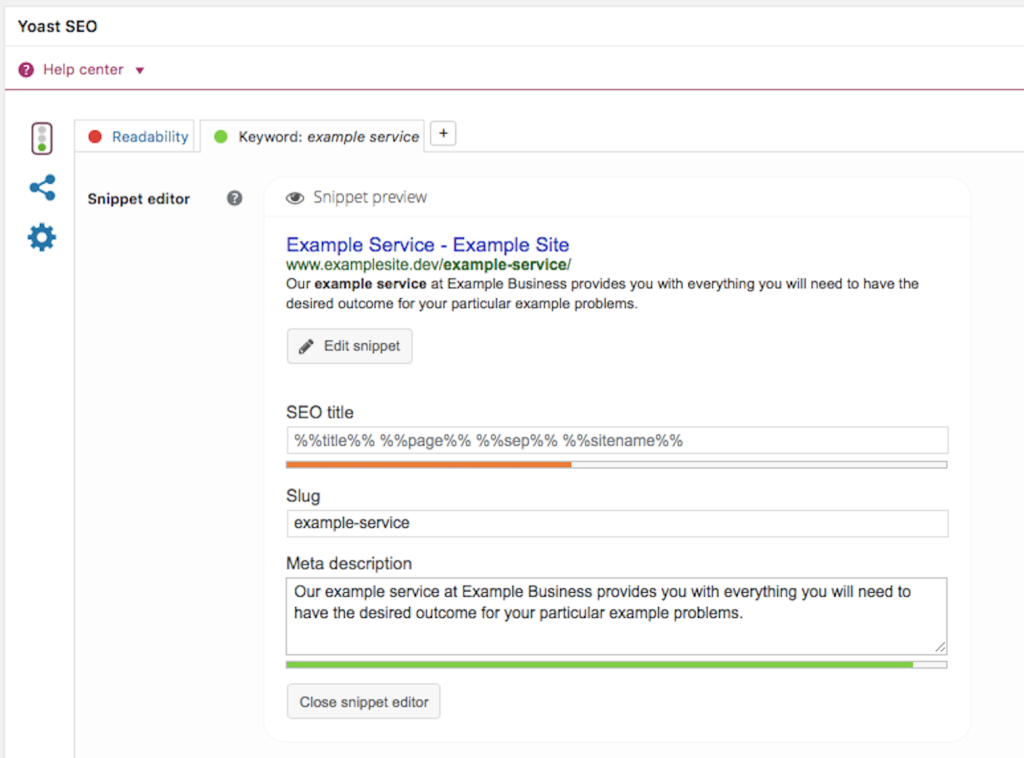
Note the area for implementing the meta description and the focus keyword, this helps Yoast provide you with SEO suggestions and advice for anything you may have missed.
So what’s the point of meta descriptions? Meta descriptions are what you see in search engine results. They tell you what the website or page content is about before you enter the website as seen in the images below:

Including meta descriptions allows your WordPress post to be seen by search users. If you don’t specify a meta description, the search engines will typically take the first sentence, which might not be ideal and entice users to visit your site. Meta descriptions themselves don’t influence search rankings, however they’re important for providing a call to action in the search results pages.
Generally, WordPress will count down the character limit for you when writing your meta description, however if you’re using a Word document you can find out the character limit of your meta description by highlighting them and clicking on the word count at the bottom left hand side of the screen.

Permalinks
Permalinks are the URLs of your posts. Permalinks tell your visitors what your link is about before they actually click into it. The words that are used in permalinks will also be highlighted (as with titles and meta descriptions) in search engine results as well when searches are relevant to a search query. In order to change your permalinks all you need to do is:
- Go into your blog and click edit on the permalink
- Change the permalink as you feel is needed
- After you’ve changed the permalink refresh the blog

![]()
Permalinks are a great way to provide a clear, relevant structure of your content.
Focus Keyword Phrases
Keyword phrases are specialized phrases which are used to optimize your pages to send more traffic to them. Key phrases are used as the core key phrase that your page will be searched for and ranked for. Think about what you want your site to be found for.
Focusing on keywords and phrases in these areas and implementing it in the Yoast SEO Focus Keyword section can help to boost your WordPress website’s overall visibility to both users and search engines. Keyword research will be covered in more detail below.

Image Alt Text (and file names)
Image file names and Alt Text are a good way to add meaning to your images to help naturally describe and define your images using relevant keywords for screen readers and search engines. File names and Alt Text can be added when you upload your images, here are the steps:
- Select the image that you’re looking to use for your blog post in the add media section. You will need to upload an image to use. Make sure you’ve renamed your images on your local computer before you upload them.
- Click on the bar where it says Alt Text on the right hand side of the screen.
- Add the keyword you’re looking to use and click ‘Insert Into Post’.

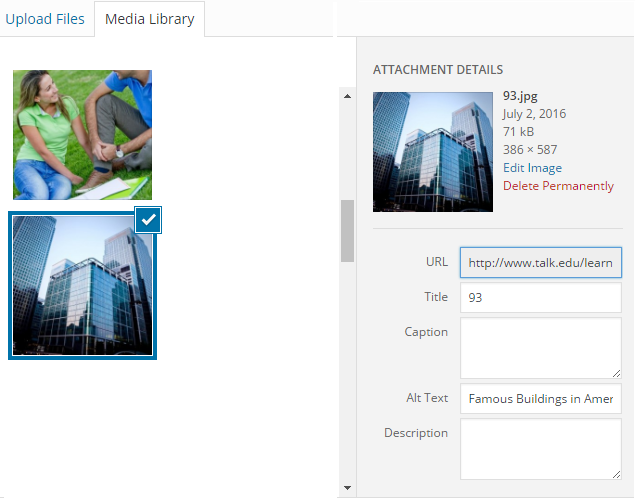
Your image will now be integrated into your content with the additional keyword information.
Internal Linking
Internal linking (or interlinking) is the process of linking one page to another page on your WordPress site. Internal linking holds many benefits, which include:
- Provides you with on-page SEO benefits
- It passes link juice from one page to the next for more post exposure
- It enables more page views which lowers the risk of a ‘high bounce rate’ and increases ‘pages per view’
- It allows search engines to crawl through and index your articles more effectively
To link one page (or post, the process is the same) to the next, all you need to do is add a hyperlink or anchor text to a word that relates with the page you’re linking it to. To insert a hyperlink, you can follow these steps:
1. Go to the page you’re looking to link to and copy the URL of the blog post.
![]()
2. Highlight a word or piece of text that you want the page to link to.
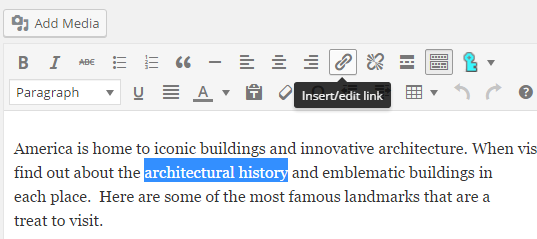
3. Click the link button along the top bar of WordPress editor and paste the relevant link into the link field and click ‘Add Link’.
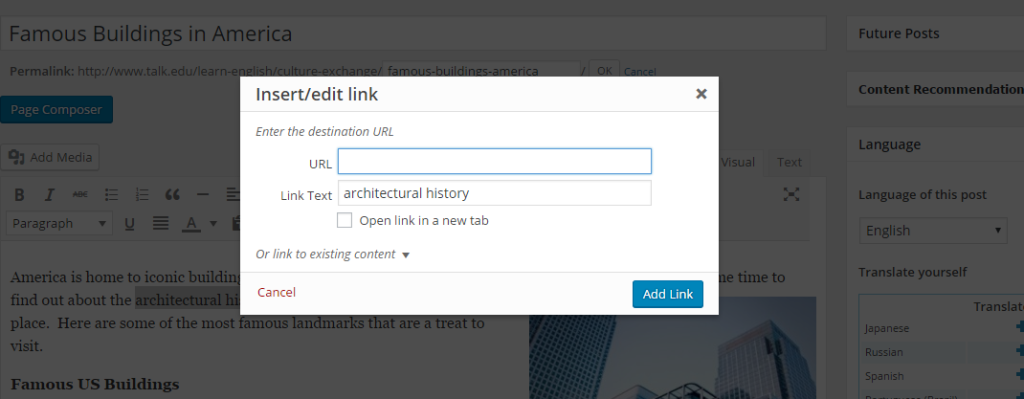
It’s really is quite easy to interlink pages and posts in your WordPress content, and best of all it can help your users and benefit your SEO.
There are many ways to achieve the same things in WordPress, explore the content editor and find what best works for you.
Yoast SEO
Yoast SEO is one of the most popular WordPress SEO plugins, it is free and is used daily by millions of WordPress users around the world. Yoast SEO offers users with on-page analysis, proper social optimization and many other features to help with SEO. The reasons why Yoast SEO is so popular is because:
- It ensures your titles and meta descriptions are optimized for your relevant keywords for better rankings on popular search engines
- It allows your website to become friendly with social media by incorporating special markup that enhances shared pages
- Prevents duplicated content through rel=canonical tag
- It provides a readability scale which helps to check how easy your content is to read for your visitors
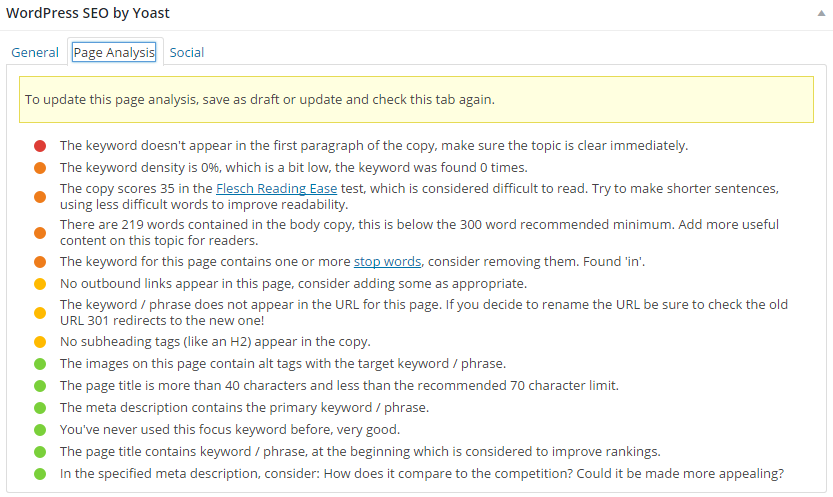
Basic Keyword Research
Keyword research is typically done at the start of your project. Keywords are the key words which are used by people to search for items on search engines. When researching the keywords to use for your WordPress site, it’s important to consider the following tips:
- Don’t just use Google Keyword Planner (which is one of the most popular tools for keyword research) for your keyword research. There are many other tools to help with this process, check out some alternatives here.
- Don’t just choose the best keywords or keyword phrases based on popularity, the more popular the keyword is, the more competition you’ll have to compete against. Instead, try using words which have low to medium competition. Although they may not be as popular, you have a higher chance of being seen than against those in the high competition range.
- Don’t just settle for generic keywords. Broad match and long tail keywords are also great options to use because they give you more direct search results for visitors to find your website.
Examples of the three different types of keywords include:
- Generic: camera, phone, clothing
- Broad Match: Canon camera, HTC phone, red clothing
- Long Tail Keywords: NX5 Series Canon Camera, HTC Desire 5 mobile phone, size 2 red baby onesie clothing.
Use keywords that best match what your page is about. There’s no point trying to use the words ‘men’s clothing’ if you’re selling young boy’s clothing. Always use appropriate keywords for the appropriate pages.

Besides Google Keyword Planner, you can also use the Search Analytics report in Google Search Console to better gauge the keywords people have used to either find your website in the search results or click through to your site. Search Analytics gives you a wealth of keyword data that can be utilized to further enhance your page.
WordPress SEO Tweaks
To help improve SEO on your WordPress site you can make a few tweaks to older content that you have previously published across the years. Some areas to tweak include:
Images
Improving the overall image quality of your blog posts and including Alt Text as suggested above can improve the SEO of your website. When uploading images, they need to be free to use. Sites where you can obtain quality images include Pixabay, ShutterStock, Fotolia, and Stock Photo Secrets to name a few. Some are free to use, while others you may have to pay a price for the images. Here’s a great article on finding copyright free images on Flickr that is worth bookmarking.
Title Changes
Changing the titles of your older pages and posts to incorporate keywords can help to improve your overall SEO. Titles should also be changed to become more intriguing and relevant to readers. The more intriguing a title is the more visitors will come to your website. Titles are also important when content is shared on social media, since it’s often the only thing people see. Take extra time learning what works for your site.
Page Speed
If a page doesn’t load within 2-3 seconds, many people will abandon your site. To make sure your page loading speed it at peak efficiency you can:
- Limit the amount of videos or other moving graphics that are placed on your posts
- Choose a good web host that has a good reputation for reliable loading speeds
- Use a Content Delivery Network (CDN)
- Optimize your images by resizing them as needed
- Optimize your homepage by removing unnecessary sharing widgets, remove inactive plugins, keeping the design minimal, show excerpts instead of entire posts, and reducing the number of page posts
Website performance and optimization is a massive area, we’ve got a previous articles on SitePoint that dig much deeper:
Conclusion
WordPress is a great option to use when setting up a website. By understanding the basics of WordPress you have a higher chance of creating a website that is optimized for users that can also rank well in search engines. If you want to share your WordPress SEO tips, we’d love to hear from you below.
The SitePoint Entrepreneur channel also has a wealth of information on SEO and other marketing strategies. You can check it out here.